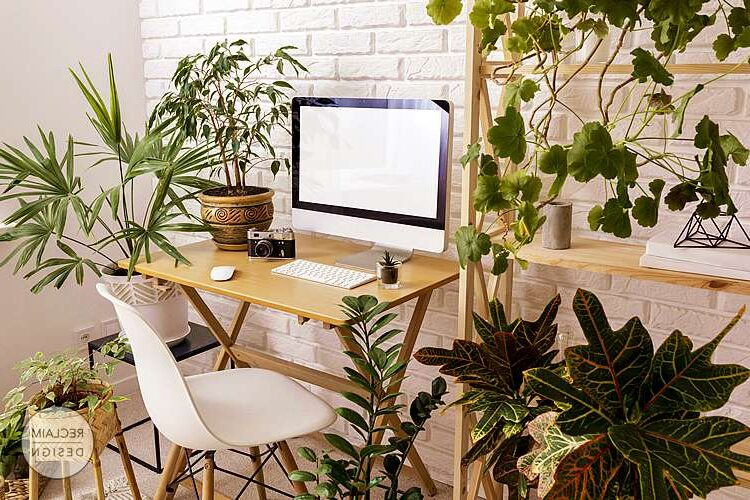The world of design is changing rapidly, adapting to new environmental and social challenges. Today, eco design is no longer just a trend — it’s a necessity. More and more people are thinking about the origins of materials, carbon footprints, recycling, and how their choices impact the planet. In 2025, we’re seeing a new stage in the evolution of this concept — with a focus on technology, mindfulness, and harmony with nature.
So what ideas and solutions will define the look and feel of interiors in the near future? Here’s an overview of the key eco design trends of 2025.
Biophilic Design 2.0
Biophilic design has been a strong trend for several years, but in 2025, it’s reaching a whole new level. It’s no longer just about a few potted plants on a windowsill — nature is being fully integrated into architecture and daily life.
What will be trending:
-
Living walls made of moss and succulents
-
Integration of water features (mini fountains, water panels)
-
Natural textures like stone, raw wood, and sandstone
-
Panoramic windows and systems that maximize natural light
-
Botanical patterns in wall finishes and textiles
Circular Design and Giving Materials a Second Life
Circular economy principles are being deeply embedded into the design world. Circular design means rethinking the entire product lifecycle — from production to reuse and recycling.
2025 trends:
-
Furniture made from recycled materials (plastic, metal, wood)
-
Restoration and redesign of old items
-
Focus on durability and repairability
-
Using production waste as a resource (e.g. coffee grounds furniture, nut shell tiles)
-
Transparent sourcing — QR codes that show material origin and maker details
Table: Comparing Outdated and Emerging Eco Design Trends
| Category | Outdated Trends (pre-2024) | New Trends in 2025 |
|---|---|---|
| Materials | Just natural materials | Recycled, biodegradable, hybrid materials |
| Plants in Interiors | Potted houseplants | Living walls, plant panels, vertical gardens |
| Furniture | Solid wood, rattan | Recycled plastic and reclaimed material |
| Color Palette | White, beige, green | Earth tones, clay, deep terracotta |
| Interior Design Approach | “Eco-style” aesthetics | Mindfulness and functionality |
Local and Small-Scale Production
Supporting local makers and producers is becoming a core value. People are growing tired of mass-market sameness and are seeking uniqueness and ethical sourcing.
Why it’s trending:
-
Lower carbon emissions thanks to reduced shipping
-
Support for artisans and local communities
-
Customization and personalized experiences
-
Transparency and higher quality
What’s in style:
-
Handmade ceramics
-
Textiles made from locally sourced eco-materials
-
Furniture and décor with history (antiques, hand-carved pieces)
Tech-Driven Eco Design
Modern technology is becoming an integral part of sustainable living. In 2025, there’s a strong focus on smart solutions that save resources and reduce environmental impact.
Key innovations:
-
Smart systems for lighting and climate control
-
Automated air and water purification
-
Energy-saving window and facade materials
-
Self-healing and shape-memory materials
-
Solar panels integrated into furniture, walls, and windows
A New Wave of Minimalism
Minimalism in 2025 is no longer about empty spaces — it’s about mindful living. People are buying less but choosing better. This philosophy fits perfectly with eco design.
Core characteristics:
-
Functionality without visual clutter
-
Neutral tones with natural material accents
-
Multifunctional furniture
-
Maximum light and airflow
Conscious Consumption in Interior Design
Every purchase is a conscious decision. In 2025, more people are asking:
-
What is it made of?
-
Who made it?
-
How long will it last?
-
Can it be recycled or reused?
Checklist for eco-conscious shopping:
-
Eco certifications (FSC, OEKO-TEX, Cradle to Cradle, etc.)
-
Locally sourced and produced
-
Contains recycled content
-
Can be safely disposed of
-
Free from toxic ingredients
2025 Colors and Textures
Eco-friendly interiors in 2025 are moving away from sterile “green” aesthetics. Trending are deep, earthy, warm tones inspired by soil, stone, leather, and clay.
Trending colors:
-
Terracotta
-
Ochre
-
Charcoal gray
-
Moss green
-
Clay pink
Popular textures:
-
Matte and rough finishes
-
Hand-molded clay
-
Coarse linen and burlap
-
Raw, imperfect wooden surfaces
Indoor Green Zones
Having at least one “living” area indoors is becoming a must-have. People want to feel closer to nature, even in urban environments.
Ideas:
-
Kitchen herb gardens on the windowsill
-
A cozy green corner for relaxation
-
Mobile plant stands and shelving with fresh herbs
-
Air-purifying houseplants
-
Vertical plant walls
Lighting as a Part of Eco Philosophy
Lighting is no longer just about function — it’s about conserving energy and enhancing space.
Popular lighting ideas:
-
Warm-spectrum LED bulbs
-
Wall sconces and spotlights to reduce energy use
-
Reflective surfaces like mirrors to spread natural light
-
Automated lighting based on daylight and time of day
How to Introduce These Trends at Home
You don’t need a full renovation to make your home more eco-friendly. Start small:
Top 7 simple steps:
-
Replace plastic organizers with natural materials
-
Install a water filter and cut down on bottled water
-
Buy furniture and décor from local artisans
-
Create a green corner at home
-
Switch to LED lighting
-
Recycle packaging and textiles
-
Choose vintage or restored items whenever possible
The year 2025 brings new depth to eco design. It’s no longer just about “green trends” — it’s a philosophy of conscious choice, respect for nature, and harmony. The focus is not on fashion, but on meaning. The spaces of the future will be not only beautiful, but smart, sustainable, and inspiring.
Eco design is no longer a style — it’s a way of life. And that’s one trend that will never go out of style.

Leave a Reply